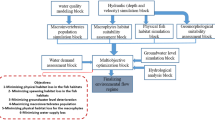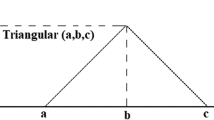Abstract
Assessment of water quality status of a river with respect to its discharge has become prerequisite to sustainable river basin management. The present paper develops an integrated model for simulating and evaluating strategies for water quality management in a river basin management by controlling point source pollutant loadings and operations of multi-purpose projects. Water Quality Analysis and Simulation Program (WASP version 8.0) has been used for modeling the transport of pollutant loadings and their impact on water quality in the river. The study presents a novel approach of integrating fuzzy set theory with an “advanced eutrophication” model to simulate the transmission and distribution of several interrelated water quality variables and their bio-physiochemical processes in an effective manner in the Ganges river basin, India. After calibration, simulated values are compared with the observed values to validate the model’s robustness. Fuzzy technique of order preference by similarity to ideal solution (F-TOPSIS) has been used to incorporate the uncertainty associated with the water quality simulation results. The model also simulates five different scenarios for pollution reduction, to determine the maximum pollutant loadings during monsoon and dry periods. The final results clearly indicate how modeled reduction in the rate of wastewater discharge has reduced impacts of pollutants in the downstream. Scenarios suggesting a river discharge rate of 1500 m3/s during the lean period, in addition to 25 and 50% reduction in the load rate, are found to be the most effective option to restore quality of river Ganges. Thus, the model serves as an important hydrologic tool to the policy makers by suggesting appropriate remediation action plans.



























Similar content being viewed by others

References
Abrishamchi A, Tajrishi M, Shafieian P (2005) Uncertainty analysis in QUAL2E model of Zayandeh-Rood river. Water Environ Res 77(3):279–286
Ajami NK, Duan Q, Sorooshian S (2006) An integrated hydrologic Bayesian multi-model combination framework: confronting input, parameter and model structural uncertainty in hydrologic prediction. Water Resour Res 43. https://doi.org/10.1029/2005WR004745
Ambrose B, Wool TA, Martin JL (2001) The Water Quality Analysis Simulation Program, WASP6, User Manual, US EPA. Athens, GA
Cardona CM, Martin C, Salterain A, Castro A, San Martín D, Ayesa E (2011) CALHIDRA 3.0—new software application for river water-quality prediction based on RWQM1. Environ Model Softw 26:973–979
Carroll RWH, Warwick JJ (2010) Evaluating the impacts of uncertainty in geomorphic channel- changes on predicting mercury transport and fate in the Carson river system, Nevada. Proc. Annual International Conference on Soils, Sediments. Water Energy 13:266–280
Chao X, Jia Y, Shields FD Jr, Wang SSY, Cooper CM (2010) Three-dimensional numerical simulation of water quality and sediment-associated processes with application to a Mississippi Delta lake. J Environ Manag 91:1456–1466
Chaudhary M, Mishra S, Kumar A (2017) Estimation of water pollution and probability of health risk due to imbalanced nutrients in River Ganga, India. Int J River Basin Manag 15(1):53–60
Conley DJ, Paerl HW, Howarth RW, Boesch DF, Seitzinger SP, Havens et al (2009) Controlling eutrophication: nitrogen and phosphorus. Science 323:1014–1015
Diaz RJ, Rosenberg R (2008) Spreading dead zones and consequences for marine ecosystems. Science 321:926–929
Fan C, Ko CH, Wang WS (2009) An innovated modeling approach using Qual2K and HEC-RAS integration to assess the impact of tidal effect on river water quality simulation. J Environ Manag 90:1824–1832
Geza M, Poeter EP, McCray JE (2009) Quantifying predictive uncertainty for a mountain watershed model. J Hydrol 376:170–181
Gomiero T, Pimentel D, Paoletti MG (2011) Environmental impact of different agricultural management practices: conventional vs. organic agriculture. Crit Rev Plant Sci 30(1–2):95–124
Hipsey MR, Romero JR, Antenucci JP, Hamilton D (2006) Computational aquatic ecosystem dynamics model: CAEDYM v2. Science Manual v2.3. University of Western Australia
Jin KR, Ji ZG, James RT (2007) Three-dimensional water quality and SAV modeling of a large shallow lake. J Great Lakes Res 33(1):28–45
Kannel PR, Lee S, Lee YS, Kanel SR, Pelletier GJ (2007) Application of automated QUAL2Kw for water quality modeling and management in the Bagmati River, Nepal. Ecol Model 202:503–517
Karaouzas I, Dimitriou E, Skoulikidis N, Gritzalis K, Colombari E (2009) Linking hydrogeological and ecological tools for an integrated river catchment assessment. Environ Model Assess 14:677–689
Kuo JT, Lung WS, Yang CP, Liu WC et al (2006) Eutrophication modelling of reservoirs in Taiwan. Environ Model Softw 21:829–844
Lai YC, Tu YT, Yang CP et al (2013) Development of a water quality modeling system for river pollution index and suspended solid loading evaluation. J Hydrol 478:89–101
Lin CE, Chen CT, Kao CM, Hong A, Wu CY (2011) Development of the sediment and water quality management strategies for the Salt-water River, Taiwan. Mar Pollut Bull 63:528–534
Lokgariwar C, Chopra R, Smakhtin V, Bharati L, O’Keeffe J (2014) Including cultural water requirements in environmental flow assessment: an example from the upper Ganga River India. Water Int 39(1):81–96
Mannina G, Viviani G (2010) Water-quality modelling for ephemeral rivers: model development and parameter assessment. J Hydrol 393:186–196
Minatour Y, Bonakdari H, Zarghami M, Ali BM (2015) Water supply management using an extended group fuzzy decision-making method: a case study in North-Eastern Iran. Appl Water Sci 5(3):291–304
MoWR (2016) River development and Ganga rejuvenation, Ganga basin. Ministry of Water Resources (MoWR), Government of India, New Delhi
Nash JE, Sutcliffe JV (1970) River flow forecasting through conceptual models part I—a discussion of principles. J Hydrol 10(3):282–290
Nikoo MR, Kerachian R, Karimi A, Azadnia AA, Jafarzadegan K (2013) Optimal water and waste load allocation in reservoir–river systems: a case study. Environ Earth Sci 79(9):4127–4142
Osmi SFC, Malek MA, Yusoff M et al (2016) Development of river water quality management using fuzzy techniques: a review. Int J River Basin Manag 14(2):243–254
Pan Q, Chhipi-Shrestha G, Zhou D, Zhang K et al (2017) Evaluating water reuse applications under uncertainty: generalized intuitionistic fuzzy-based approach. Stoch Env Res Risk A. https://doi.org/10.1007/s00477-017-1449-1
Park RA, Clough JS, Wellman MC (2008) AQUATOX: modeling environmental fate and ecological effects in aquatic ecosystems. Ecol Model 213:1–15
Paul D (2017) Research on heavy metal pollution of river Ganga: a review. Ann Agrar Sci 15(2):278–286
Rangel Peraza JG, Anda JD, Gonzalez Farias FA et al (2016) Sensitivity and uncertainty analysis on water quality modelling of Aguamilpa Reservoir. J Limnol 75(1):81–92. https://doi.org/10.4081/jlimnol6.1391
Reckhow KH (1994) Water quality simulation modeling and uncertainty analysis for risk assessment and decision making. Ecol Model 72:1–20
Rehana S, Mujumdar PP (2009) An imprecise fuzzy risk approach for water quality management of a river system. J Environ Manag 90(11):3653–3664
Sagehashi M, Sakoda A, Suzuki M (2000) A predictive model of long-term stability after biomanipulation of shallow lakes. Water Res 34:4014–4028
Segrave AJ, Vander Zouwen MW, Van Vierssen W (2014) Water planning: from what time perspective? Technol Forecast Soc Chang 86:157–167. https://doi.org/10.1016/j.techfore.2013.08.019
Shojaei M, Nazif S, Kerachian R (2015) Joint uncertainty analysis in river water quality simulation: a case study of the Karoon River in Iran. Environ Earth Sci 73:3819–3831
Singh AP, Ghosh SK (2003a) Conceptual modeling and management of water quality in a river basin in recent trends. In: Ramanathan AL, Ramesh (eds) Hydrogeochemistry. Capital Books, New Delhi, pp 207–220
Singh AP, Ghosh SK (2003b) Uncertainty analysis in river basin water quality management. In: Raju KS, Sarkar AK, Dash ML (eds) Integrated water resources planning and management. Jain Brothers, New Delhi, pp 260–268
Singh AP, Ghosh SK, Sharma P (2007) Water quality management of a stretch of river Yamuna: an interactive fuzzy multi-objective approach. Water Res Manage 21(2):515–532
Singh AP, Srinivas R, Kumar S, Chakrabarti S (2015) Water quality assessment of a river basin under fuzzy multi-criteria framework. Int J Water 9(3):226–247
Srinivas R, Singh AP (2017) Impact assessment of industrial wastewater discharge in a river basin using interval-valued fuzzy group decision-making and spatial approach. Int J Enviro Dev Sustain Springer. https://doi.org/10.1007/s10668-017-9994-9
Srinivas R, Singh AP, Sharma R (2017) A scenario based impact assessment of trace metals on ecosystem of river Ganges using multivariate analysis coupled with fuzzy decision-making approach. Water Resour Manag 31(13):4165–4185
Tare V, Gurjar SK, Mohanta H, Kapoor V et al (2017) Eco-geomorphological approach for environmental flows assessment in monsoon-driven highland rivers: a case study of Upper Ganga, India. J Hydrol 13:110–121
Trancoso AR, Braunschweig F, Leitão PC et al (2009) An advanced modelling tool for simulating complex river systems. Sci Total Environ 407:3004–3016
UPJN, UPPCB, CPCB (2017) Assessment of pollution of drains carrying sewage/industrial effluent joining River Ganga and its tributaries. A joint report by Uttar Pradesh Jal Nigam (UPJN), Uttar Pradesh Pollution Control Board (UPPCB), Lucknow and Central Pollution Control Board (CPCB) New Delhi, India
UPPCB (2013) Pollution caused by leather tanning industry to the water bodies/ground water in Unnao District of Uttar Pradesh. Uttar Pradesh Pollution Control Board (UPPCB), Lucknow
Vemula VRS, Mujumdar PP, Ghosh S (2004) Risk evaluation in water quality management of a river system. J Water Resour Plan Manag 130(5):411–423
Vrugt JA, Gupta HV, Bouten W, Sorooshian S (2003) A shuffled complex evolution metropolis algorithm for optimization and uncertainty assessment of hydrologic model parameters. Water Resour Res 39(8):1201. https://doi.org/10.1029/2002WR001642
Wang JQ, Zhong Z, Wu J (2004) Steam water quality models and its development trend. J Anhui Normal Univ (Nat Sci) 27(3):243–247
Wang Z, Zou R, Zhu X et al (2014) Predicting lake water quality responses to load reduction: a three-dimensional modeling approach for total maximum daily load. Int J Environ Sci Technol 11:423–436
Warmink JJ, Klis HV, Booij MJ et al (2011) Identification and quantification of uncertainties in a hydrodynamic river model using expert opinions. Water Resour Manag 25:601–622
Wool TA, Ambrose RB, Martin JL, Comer EA (2001) The water quality analysis simulation program WASP6 draft, users’ manual. US Environmental Protection Agency, GA
Xu Z, Godrej AN, Grizzard TJ (2007) The hydrological calibration and validation of a complexly-linked watershed–reservoir model for the Occoquan watershed, Virginia. J Hydrol 345:167–183
Yazdi J, Moridi A (2017) Interactive reservoir-watershed modeling framework for integrated water quality management. Water Resour Manag 31:2105–2125
Ye HF, Guo SH, Li FM, Li G (2013) Water quality evaluation in tidal river reaches of Liaohe river estuary, China using a revised QUAL2K model. Chin Geogr Sci 23:301–311
Yeh KC, Tung YK (1993) Uncertainty and sensitivity analyses of pit-migration model. J Hydraul Eng ASCE 119(2):262–283
Zhang ML, Shen YM, Guo Y (2008) Development and application of a eutrophication water quality model for river networks. J Hydrodyn 20:719–726
Zhang RB, Qian X, Li HM, Yuan XC, Ye R (2012) Selection of optimal river water quality improvement programs using QUAL2K: a case study of Taihu lake basin, China. Sci Total Environ 431:278–285
Zhang W, Jin X, Liu D et al (2017) Temporal and spatial variation of nitrogen and phosphorus and eutrophication assessment for a typical arid river—Fuyang River in northern China. J Environ Sci 55:41–48
Zhao X, Shen Z, Xiong M, Qi J (2011) Key uncertainty sources analysis of water quality model using the first order error method. Int J Environ Sci Technol 8(1):137–148
Zheng Y, Keller AA (2008) Stochastic watershed water quality simulation for TMDL development—a case study in the new port bay watershed. J Am Water Resour Assoc 44(6):1397–1410
Zhu H, Huang GH, Guo P, Qin QS (2009) A fuzzy robust nonlinear programming model for stream water quality management. Water Res Manage 23:2913–2940
Acknowledgements
The authors are grateful to BITS Pilani, India, for providing necessary facilities to carry out this research work. Authors are also thankful to CWC, Lucknow, and CPCB, New Delhi, for sharing information on river Ganges. The software WASP (version 8.0) used for the entire modeling has been provided by US Environmental Protection Agency. All references cited in the text have provided the detailed insight about the subject matter and therefore are greatly acknowledged. We also express our sincere thanks to the anonymous reviewers and editors for their valuable comments and time.
Author information
Authors and Affiliations
Corresponding author
Additional information
Responsible editor: Marcus Schulz
Rights and permissions
About this article
Cite this article
Srinivas, R., Singh, A.P. An integrated fuzzy-based advanced eutrophication simulation model to develop the best management scenarios for a river basin. Environ Sci Pollut Res 25, 9012–9039 (2018). https://doi.org/10.1007/s11356-018-1206-0
Received:
Accepted:
Published:
Issue Date:
DOI: https://doi.org/10.1007/s11356-018-1206-0



